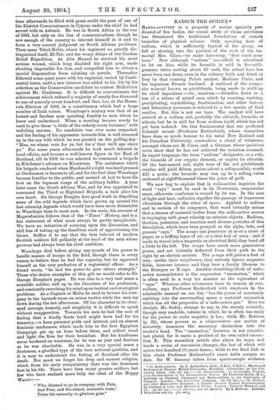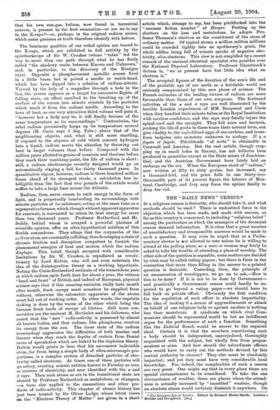RADIO-ACTIVITY is a property of matter specially pre- dicated of
five bodies, the recent study of whose attributes has threatened the traditional foundations of certain branches of physical science. Only speaking here of radium, which is sufficiently typical of the group, we fall at starting . into the position of the cook of the im- mortal Mrs. Glass,—to make hare-soup, "first catch your hare." Now although "radium" (so-called) is advertised to let on hire, while its bromide is sold in five-milli- gramme tubes costing about E8 each, the actual bare has never been run down, even in the refinery built and fitted at Ivry by that cunning Polish analyst, Madame Curie, and her ingenious French husband. A cartload of the compo- site mineral known as pitchblende, being made to yield up its chief ingredient — viz., uranium — dwindles down to a ton of a refuse of mixed ores, which by roasting, washing, precipitating, crystallising, fractionation, and other factory and laboratory processes is reduced to a few specks of final residue. But this is not our bare. The analyst will have arrived at a radium salt, probably the chloride, bromide, or nitrate, but he is still far from radium itself, which has not yet been isolated. On this fundamental fact our profound Colonial savant (Professor Rutherford), whose researches have done so much honour to his natal New Zealand and his Canadian University, contradicts a cloud of witnesses, amongst whom are M. Curie, and a German whose ipsissima verba show that he has not achieved the isolation assumed. In expert language, the term " radium " designates, as a rule, the bromide of our cryptic element, or maybe its chloride. Of the last-named salt, eight tons of the red pitchblende residue will yield fifteen grains (about a saltspoonful), worth 225 a grain : the bromide may run up to a selling value reckoned at eightfthousand times the price of gold.
We now beg to explain that in radio-active inquiries the word " rays " must be read in its Newtonian, corpuscular sense, otherwise confusion is caused by its UM. In the case of light and heat, radiation signifies the passage of transverse vibrations through the ether of space. Applied to radium and to certain of its congeners, that word virtually means that a stream of material bodies from the radio-active source is impinging with great velocity on exterior objects. Radium, thorium, polonium, and uranium emit diverse particles of this description, which have been grouped as the alpha, beta, and gamma "rays." The a-rays can penetrate at most a skeet of paper, or a trifling layer of air, or a thin leaf of mica : and if made to travel into a magnetic or electrical field, they bend off a little to the left. The /3-rays have much more penetrative power, and are violently deflected from their path to the right by an electric current. The y-rays will pierce a foot of iron : unlike their neighbours; they entirely ignore magnetic fields, however intense, and they bear a family likeness to the Röntgen or X rays. Another stumbling-block of radio- active nomenclature is the expression "emanation," which is often used in a very lax manner as the equivalent of "rays." Whereas other substances have to remain at rest, radium, says Professor Rutherford with emphasis in the admirable manual on our list, "has the power of constantly emitting into the surrounding space a material emanation which has all the properties of a radio-active gas." Here his disciple, Mr. Soddy, strange to say, in the sternly scientific, though very readable, volume in which he is often too ready for the jurare in verba magistri, is lax ; while Mr. Bottone (p. 22), whose powers as a vulgarisateur are matter of notoriety, hammers the necessary distinction into the reader's head. The "emanation," however, is not singular, but plural, for it emits a product of its own called emana- tion X. This secondary article also alters its ways, and heads a series of successive changes, the last of which will arrive two hundred (?) years hence ; while to the final link in this chain Professor Rutherford's exact table assigns no date. Sir W. Ramsay infers from spectroscopic evidence • (1) Radio-activity. By E. Rutherford, D.Sc. F.R.S., F.R.S.C., Macdonald Professor of Physics, McGill University, Montreal. Cambridge : at the Uni. versity Press. [lOs. 6d. net.]—(2) Radio-activity: an Etementary Treatise, from the Standpoint of the Disintegration Theory. By Frederick Soddy, MA., Lecturer on Physical Chemistry and Radio-activity in the University of Glasgow. London: The Electrician Company. [tis. 6d. net.]—(3) Radium, and other Radio-active Elements : a Popular Account Treated Experimentally. By Leonard A. Levy and Herbert J. Willis. Loudon Percival Marshall and Co. L2s. 6d. net.3—(4) Radium, and dll About It. By S. Bottone. London Whittaker and Co. Da. net.j
that his own sun-gas, helium, now found in terrestrial sources, is present in the first emanation—or are we to say in the X-rays ?—or, perhaps, in the original radium atoms, which some guessers at truth therefore identify with helium.
The luminous qualities of our veiled sphinx are traced to the X-rays, which are exhibited in full activity by the spinthariscope of Sir W. Crookes (whose "tubes" led the way to more than one path through what he has finely called "the shadowy realm between Known and Unknown," and, in particular, to the discovery of the Röntgen rays). Opposite a phosphorescent metallic screen fixed in a little brass box is poised a needle or watch-hand, which has been dipped into a solution of radium-nitrate. Viewed 1)3, the help of a magnifier through a hole in the box, the screen appears as a target for successive flights of falling stars, an effect ascribed to the breaking up of the surface of the screen into minute crystals by the particles which reach it from the radiant needle. According to the laws of heat, as our very attractive third volume well puts it, "however hot a body may be, it will finally become of the same temperature as its surroundings." Contrariwise, the rebel radium persistently keeps up its temperature several degrees (M. Curie says 5 deg. Fa.hr.) above that of the neighbouring objects, and, what is still more startling, if exposed to the abysses of cold which convert hydrogen into a liquid, radium meets the situation by throwing out heat in larger volumes than before. Compared with the million years allotted to grains of uranium and thorium before they reach their vanishing-point, the life of radium is short: still, a radium electroscope recently designed would go on automatically ringing a bell for thirty thousand years. In quantitative vigour, however, radium is three hundred million times ahead of its strongest rivals, a calculation less in- telligible than the fact that two pounds of the article would suffice to take a large liner across the Atlantic.
Radium, then, never ceases to emit energy in the form of light, and is perpetually bombarding its surroundings with minute particles of its substance, acting at the same time as a regenerative furnace, which, though without apparent apparatus for renewals, is warranted to retain its heat energy for more than two thousand years. Professor Rutherford and Mr. Soddy, behind whom is arrayed a powerful phalanx of scientific opinion, offer an ultra-hypothetical solution of this double conundrum. They allege that the corpuscles of the radium atom are constantly colliding, thus developing a state of chronic friction and disruption competent to furnish the phenomenal energies of beat and motion which the radium displays. This belief, though accepted with considerable limitations by Sir W. Crookes, is repudiated as revolu- tionary by Lord Kelvin, who will not even entertain the idea of the disintegration theory as a working hypothesis. Noting the Curie-Rutherford estimate of the tremendous pace at which radium spits forth heat for about a year, the veteran "head and front" of British, and indeed of European, physical science says that if this amazing emission really lasts month after month, fresh energy must somehow be supplied from without, otherwise the calometric apparatus of the atoms must fall out of working order. In other words, the requisite stoking is done by the waves of the ether which bring the furnace fresh loads of energy ad libitum. Still more con- servative are the eminent M. Berthelot and his followers, who assert that the " new " radio-activity is possessed by almost all known bodies, and that radium, like phosphorus, receives its energy from the sun. The loose state of the radium terminology aggravates the difficulties of both teacher and learner when they reach the depths of certain Dom Daniel caves of speculation which are linked to the explosion theory. Dalton would grieve to hear that his sacrosanct indivisible atom, far from being a simple body of ultra-microscopic pro- portions, is a complex system of detached particles of elec- tricity called electrons. At times one of these particles will go astray, creating minute entities known to Faraday as ions, or carriers of electricity, and now identified with the a and
rays. Then such atoms as are in the transitional state are classed by Professor Rutherford as metabolons, or changers, —a term also applied to the emanations and other pro- ducts of radio-activity. This chapter of atomic history has just been treated by Sir Oliver Lodge, whose latest views
• The Religious Life of London. Edited by Riebard Kadin-Smith. London s OR the "Electron Theory of Matter" are given in a short Hodder and Stoughton. Ds.] article which, strange to say, has been pitchforked into the "summer fiction number" of Harper. Putting up the shutters on the ions and metabolons, he adopts Pro- fessor Thomson's electron as the constituent of the atom of ordinary matter. Of typical atoms, a million million millions could be crowded tightly into an apothecary's grain, the whole edifice being full of minute specks of negative elec- tricity, alias electrons. This view is not simplified by a recent remark of the eminent electrical specialist who presides over the National Physical Laboratory. Professor Glazebrook's dictum is, "we at present have but little idea what an electron is."
The accepted figures of the duration of the sun's life and of the probable age of our earth as a habitable world are seriously compromised by this new phase of science. The French estimates of the healing virtues of radium are more favourable than those of our own surgeons. The firebrand activities of the a and gi rays are well illustrated by the terrible London experiences of MM. Becquerel and Curie when they handled their minute tubes at the Royal Institution with careless confidence, and the rays may fatally injure the spinal cord and the eyesight. They kill mice and bacteria, prolong the life of grubs to three times their natural term, can give vitality to the unfertilised eggs of sea-urchins, and trans- form tadpoles into monsters unknown to zoology. It y a fagots et fagots. Pitchblende "of sorts" is obtainable in Cornwall and America. But the real article, though crop- ping up in small lodes in Saxony, has not hitherto been produced in quantities except at the State mines of Joachims- thal, and the Austrian Government have lately laid an embargo on the ore. When the European stock of "radium," now written at fifty to sixty grains, has increased, say a thousand-fold, and the price falls to one thirty-two- thousandth part of its present figure, the labours of Mon- treal, Cambridge, and Ivry may force the sphinx finally to drop her veil.



































 Previous page
Previous page